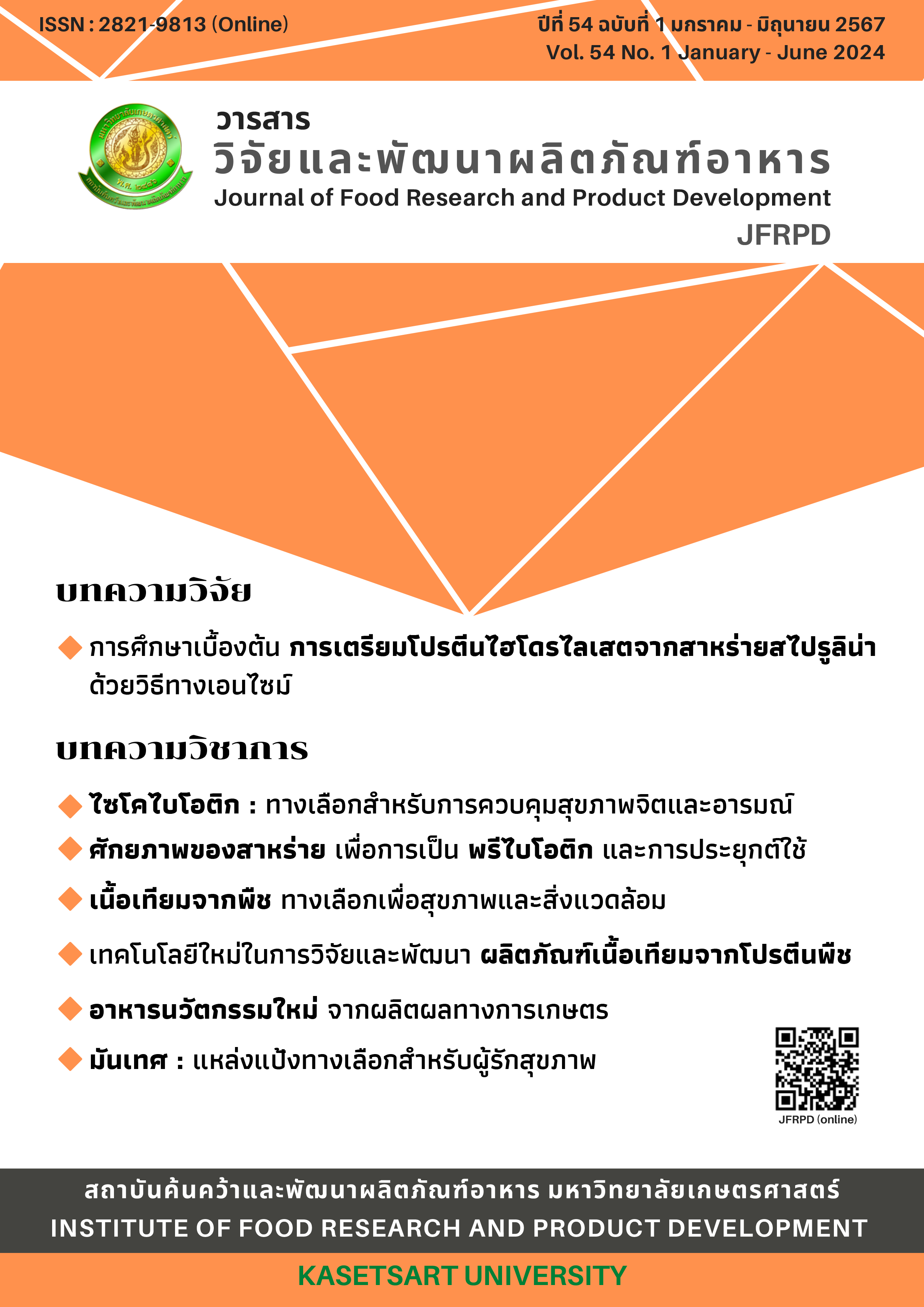Plant-based meat : A new option for health and the environment
##plugins.themes.bootstrap3.article.main##
摘要
Growth in meat consumption is projected to increase in developing regions due to high population levels and growth rates. This has led to increased production to meet market demand, which causes environmental damage, animal welfare, and human health. To solve this problem, the concept of meat analogue has to emerge as a more sustainable and satisfying consumer. The process of making meat analogue entails a variety of ingredients, including algae, edible insects, and legumes, to imitate the texture and taste of meat. In meat analogue production, the proteins are mixed with fat and other ingredients through an extrusion. High-moisture extrusion is the most environmentally friendly process for producing meat analogue, and it is also more efficient than other meat analogue manufacturing processes. Meat analogue has the potential to reduce the environmental impact of the food system, improve animal welfare, and promote human health. However, it is still a relatively new product, and more research is needed to optimize its production and nutritional value.
##plugins.generic.usageStats.downloads##
##plugins.themes.bootstrap3.article.details##
参考
Nations UNIES. World population prospects 2019: highlights. Department of Economic and Social Affairs, Population Division. Nosworthy, M. G., & House, J. D. (2017). Factors influencing the quality of dietary proteins: Implications for pulses. Cereal Chemistry. 2019;94(1):49-57.
Kyriakopoulou K, Dekkers B, van der Goot AJ. Plant-based meat analogues. Sustainable meat production and processing: Elsevier; 2019. p. 103-26.
ZionMarketReport. Global Plant Based Meat Market Will Reach USD 21.23Billion by 2025: Zion Market Research. 2019. p. https://www.globenewswire.com/news-release/2019/03/28/1781303/0/en/Global-Plant-Based-Meat-Market-Will-Reach-USD-21-23-Billion-By-2025-Zion-Market-Research.html
Meade SJ, Reid EA, Gerrard JA. The impact of processing on the nutritional quality of food proteins. J AOAC Int. 2005;88(3):904-22.
Xia Y, Qian J, Zhao Y, Zheng B, Wei K, Peng B, et al. Effects of food components and processing parameters on plant-based meat texture formation and evaluation methods. J Texture Stud. 2023;54(3):394-409.
Webb D, Li Y, Alavi S. Chemical and physicochemical features of common plant proteins and their extrudates for use in plant-based meat. Trends Food Sci Technol. 2022.
Baune M-C, Terjung N, Tülbek MÇ, Boukid F. Textured vegetable proteins (TVP): Future foods standing on their merits as meat alternatives. Future Foods. 2022:100181.
Nowacka M, Trusinska M, Chraniuk P, Drudi F, Lukasiewicz J, Nguyen NP, et al. Developments in plant proteins production for meat and fish analogues. Molecules. 2023;28(7):2966.
Imran M, Liyan Z. Production of plant-based meat: functionality, limitations and future prospects. European Food Res Technol. 2023:1-25.
Calkins CR, Hodgen JM. A fresh look at meat flavor. Meat Sci. 2007;77(1):63-80.
Sha L, Xiong YL. Plant protein-based alternatives of reconstructed meat: Science, technology, and challenges. Trends Food Sci Technol. 2020;102:51-61.
Yang D, Gao S, Yang H. Effects of sucrose addition on the rheology and structure of iota-carrageenan. Food Hydrocoll. 2020;99:105317.
Palanisamy M, Töpfl S, Aganovic K, Berger RG. Influence of iota carrageenan addition on the properties of soya protein meat analogues. LWT. 2018;87:546-52.
Wang Z, Tian B, Boom R, van der Goot AJ. Air bubbles in calcium caseinate fibrous material enhances anisotropy. Food Hydrocoll. 2019;87:497-505.
Dekkers BL, Boom RM, van der Goot AJ. Structuring processes for meat analogues. Trends Food Sci Technol. 2018;81:25-36.
Saerens W, Smetana S, Van Campenhout L, Lammers V, Heinz V. Life cycle assessment of burger patties produced with extruded meat substitutes. J Clean Prod. 2021;306:127177.
Hughes GJ, Ryan DJ, Mukherjea R, Schasteen CS. Protein digestibility-corrected amino acid scores (PDCAAS) for soy protein isolates and concentrate: Criteria for evaluation. J Agric Food Chem. 2011;59(23):12707-12.
Nosworthy MG, House JD. Factors influencing the quality of dietary proteins: Implications for pulses. Cereal Chem. 2017;94(1):49-57.
Kumar P, Chatli M, Mehta N, Singh P, Malav O, Verma AK. Meat analogues: Health promising sustainable meat substitutes. Critical reviews in food science and nutrition. 2017;57(5):923-32.
Tarté R. Ingredients in meat products: properties, functionality and applications: Springer; 2009.
Schuh V, Allard K, Herrmann K, Gibis M, Kohlus R, Weiss J. Impact of carboxymethyl cellulose (CMC) and microcrystalline cellulose (MCC) on functional characteristics of emulsified sausages. Meat Sci. 2013;93(2):240-7.
Bohrer BM. An investigation of the formulation and nutritional composition of modern meat analogue products. Food Sci Hum Wellness. 2019;8(4):320-9.
Graça J, Godinho CA, Truninger M. Reducing meat consumption and following plant-based diets: Current evidence and future directions to inform integrated transitions. Trends Food Sci Technol. 2019;91:380-90.

